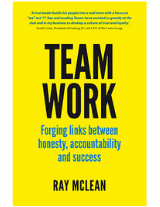Around this time of the year, every year, AFL clubs are going through a process of selecting their leadership groups. Often there are quite a few different selection processes but I’d like to focus on the Hawthorn Football Club selection process and how that’s been done over many years.
Hawthorn coach Alastair Clarkson with 2008 winning captain Sam Mitchell
Our first engagement with Hawthorn was when Alastair Clarkson started coaching in 2004 and one of the pillars of the work that we do with Leading Teams and Hawthorn is to select a group of leaders from their peers.
We allow players five selections, they read those selections out in an open forum and we tally up the votes up as a guide and then somewhere in that number there will be a group of leaders emerge. We do not have a set number of leaders we have to get to, we simply look at where there seems to be a logical cut off. Usually the leadership group ends up being between 5-8. The process is to identify a leadership group and out of that process a captain will emerge. Identifying a captain is not the purpose of the vote.
Know what you’re looking for in a leader
At Leading Teams, the most important step initially is to have established some sort of cultural identity. We call this a trademark. This gives you the criteria you’re selecting leaders against. If you don’t know what culture you trying to build, then it really doesn’t matter who you pick as leader.
When we are selecting leaders, the pivotal conversation is about trust. We focus on two different elements of trust. The first one is the competence of the person. Knowing that they can do their job is an important aspect of leadership. The second part is the character of the person. This is often the one which is a little more difficult to define, but if you have a cultural statement or a cultural guide, that gives you clarity. When you are making your selection for a leader you need to be sure the leader is going to preserve your culture, drive your culture, and model the behaviour required within your culture.
Hawthorn’s first leadership group
As you go through that selection process, it seems a simple thing: five picks, put them up on the board, there you have it. But it’s really the education and the commitment behind the process that is very important. At Hawthorn, there was a lot of work done in establishing the type of culture the club aspired to, having come from the brink of oblivion (the proposed merger with Melbourne) prior to Alastair Clarkson taking over as coach.
Significantly in the first leadership selection process there were certainly more talented players on the list than Richie Vandenberg but after the voting process Richie’s standing in the group was clear. The process sent a resounding message both internally and externally about the criteria for leadership at Hawthorn. The selection process yielded a leader that understood the level of commitment required to create the culture that they wanted and there were no doubts as to his capacity to play a role for the team and be the selfless leader that he was.
This was a significant step in the early days of the cultural change at Hawthorn. There is no doubt there were several potentially very good young players in the system who would have had some leadership attributes but were not ready. At Leading Teams, we look back and say that Richie Vandenberg had to do some heavy lifting in a period where the young players were growing and developing and the club was laying the foundation for success. There was going to be some pain and losses along the way and the club needed someone strong to stand for that period. This enabled Sam Mitchell, Luke Hodge, Jarryd Roughead and others to understand the culture they were trying to build. Subsequently in three or four years we started to see them emerge as leaders and they began to figure in the selection process. We had created a culture of leadership that paralleled the club culture we were trying to perpetuate.
Choosing their current captain
It’s interesting that only a few weeks ago, the club again announced that they had been through the same process. I was facilitating the session. We had an open ballot: five votes each, we tallied them up on the board and there was a very clear cut of leaders. From there the leadership group, together with the coaches, discussed captaincy. We had distinguished the difference between the leadership group and the captaincy.
Luke Hodge believed it was time for him to hand over the captaincy, so, in a very mature process, we discussed the next best fit which was Jarryd Roughead. Importantly for Jarryd, he wasn’t thrown in because “he’s a great player” or “he’s a good bloke’ … Jarryd is a great fit culturally and he will have the competence and character to stand up.
What will help him stand up as a leader will be the support of the leadership group and the broader team. There is congruency with what the club expects and what the leadership group are going to deliver.
Is it possible that we could put the same rigour and congruency around leadership selection in our corporate teams?
Imagine the lessons we could take from this process back into our corporate teams. What value does your organisation really place on leadership in relation to performance? At Leading Teams, we are now a team of 18 and we go through the same process. Myself and Kraig Grime, the owners of the business, give a broad vision and a sense of the direction we would like to take but then as a group we sit around a table, we have three votes each, we put those on the board, we establish a leadership group and from there that leadership group take carriage of the key performance areas for us and make strong recommendations on policy for our business. Kraig and I trust our team, our leaders, and our selection process.
I believe the equation is simple – the wider the gap between the leader’s behaviour and the espoused values of the company, the greater risk of poor performance or failure. The collapse of Enron in America might be the greatest example of all! They focused totally on talent and ignored character. Their company values were respect, integrity, communication, and excellence. When the company failed and their executives were being locked up it would be fair to say there may have been a reasonable gap between their espoused values and their actual leadership behaviour!
Ray founded Leading Teams in 1992 after working as a leadership officer with the Air Force. He has published two books, ‘Any Given Team’ and ‘Team Work’. Ray is based in Geelong.
Learn more about Ray.



